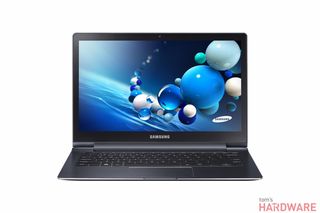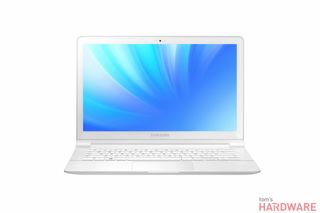Preview: Samsung ATIV Book 9 Plus and Lite Ultrabooks
Samsung's rolling out new ultrabooks, one of which has the crazy resolution of 3200 x 1800.
Last week we reported on Samsung's entry into the Windows 8 Ultrabook convertible market, the ATIV Q. At the same event, we also got the chance to check out their latest traditional Ultrabooks, the ATIV Book 9 Plus and ATIV Book 9 Lite. The Book 9 Plus is an update to the 13" Full HD Series 9 Ultrabook that we covered earlier this year, and that model itself was just an update to a 2012 model that did not have the 1080p screen. The Book 9 Lite, though is an all-new model that uses the same design language as the other Book 9's, but is more reasonably priced, due to its lower-end specs and plastic construction. For a closer look at both Book 9 Ultrabooks, watch the short video above.
ATIV Book 9 Plus

The first model we got to look at was the ATIV Book 9 Plus. While its name follows Samsung's new conventions, its form-factor is identical to the 'New' Series 9 Ultrabooks from 2012. By doing this, Samsung seems to be taking a page from Apple's MacBook Air playbook - the Series 9 is/was one of the best designed Ultrabooks, and Samsung doesn't want to mess with success. The Book 9 Plus has the same attractive, thin (13.6 mm), light (1.39 kg / 3.06 lbs), duralumin 'Mineral Ash Black' chassis and connectivity options as the previous models (albeit with an upgrade to dual USB 3.0 ports, instead of just one USB 3.0 and one USB 2.0). The big changes can be found in the screen and under the hood.
The stand-out feature of the Book 9 Plus is its ultra-high resolution QHD+ 13.3" 3200 x 1800 multi-touch screen, which is also found in the ATIV Q convertible. Its unbelievable resolution is an incredibly crisp 275 PPI, which beats the Retina display found in the 13" MacBook Pro. It is a PLS panel, which is Samsung's version of IPS, so the viewing angles are great. One issue right now, though, with such a high-resolution is that Windows 8 doesn't scale to screens with such high DPI. Windows 8.1 addresses this, but it won't be released until after the Book 9 Plus goes on sale.



The other update under the hood is a move to Intel's new Haswell CPUs, in this case an i5-4200U CPU. Unfortunately, as we mentioned in our look at the ATIV Q, Samsung's choice to use the entry-level ULV i5 Haswell means that the Book 9 Plus only has HD 4400 graphics. If Samsung had instead opted for the next step up, an i5-4250U CPU (which is also found in the new MacBook Air), the Book 9 Plus would have Intel's faster HD 5000 integrated GPU. Interesting, the i5-4200U does have a higher base clock speed than the 4250U (1.6 GHz vs. 1.3 GHz), so perhaps from a marketing perspective Samsung values a faster CPU over a better GPU. While Samsung was able to be specific with us at the meeting, the combo of Haswell's power efficiency and a big 55 Wh battery means that (according to Samsung's global ATIV site) the Book 9 Plus should run for an amazing 11 hours.
The final specifications haven't been announced, but the model we were shown had 4 GB of RAM and a 128 GB SSD, which seem a little modest, especially since Samsung is saying that it will retail for $1500 when it is launched in early August. However, there is obviously a price to be paid for an Ultrabook with such an amazing screen, and if you want something with a little more power, perhaps Samsung will release an upgraded model with more RAM and a bigger SSD later. Don't expect that to be cheap, though.
ATIV Book 9 Lite
Stay on the Cutting Edge
Join the experts who read Tom's Hardware for the inside track on enthusiast PC tech news — and have for over 25 years. We'll send breaking news and in-depth reviews of CPUs, GPUs, AI, maker hardware and more straight to your inbox.

At first glance, the Book 9 Lite looks identical to the Book 9 Plus, just made from plastic, but on closer inspection it is slightly thicker at 16.9 mm, vs. the Plus's 13.6 mm. It is also a little heavier, weighing 1.44 kg (3.17 lbs), which is surprising considering it is made from plastic. However, one would assume the in order to make the Lite as sturdy as its metal relatives its internal construction would have to be a bit beefier. While we were only shown the 'Marble White' Book 9 Lite, it will also be available in a 'Mineral Ash Black' version too.
The Book 9 Lite also has a lower-end screen, in fact, a much lower-end screen. The unit we were shown only had a 1366 x 768 LED backlit TN touch-screen panel. It wasn't awful, per se, but paled in comparison to the screen in the Book 9 Plus. Of course, in order to keep costs down there always has to be compromises, and with the screen being one of the most expensive components in a notebook, it's one of the first casualties. There is also supposed to be a non-touch screen version of the Book 9 Lite, but we were not shown this model at the event.



The Book 9 Lite's CPU is officially advertised as just a 1.4 GHz 'Quad-Core processor', but from talking to Samsung at the event, we learned that is actually a white label AMD processor, which they claim was custom designed for the Book 9 Lite. In reality, though, it is more likely just simply be a new Jaguar Core APU, but we'll have to wait until we get a Book 9 Lite to test to confirm this. It is interesting that Samsung has gone to some length NOT to identify in their marketing for the Book 9 Lite that is powered by an AMD processor, but are quite happy to advertise that it has AMD Radeon graphics.
While Samsung didn't share with us the event the Book 9 Lite's battery life, it's a given that being a lower-end model that it would not be as good as the Book 9 Plus. On Samsung's official page for the Book 9 Lite we can see that it has up to 5.5 hours of battery life, which is probably more explained by the 2-cell 30 Wh battery that the Lite comes with, rather than the AMD APU being a power-hog.
The other specifications of the Lite are similar to the Plus. For connectivity it has mini-VGA (dongle required), micro-HDMI, one USB 2.0, one USB 3.0, a 3-in-1 (SD/SDHC/SDXC) card reader, and Gigabit Wired Ethernet LAN port, through an included dongle. Like the Book 9 Plus, the Book 9 Lite also has 4 GB of RAM and a 128 GB SSD drive. These lower specifications are more in line with what would be expected from an Ultrabook at this price point, which will be $830 when the Book 9 Lite launches very soon.
Hopefully we will be able to spend some additional time with the new Book 9's soon, so check back with us for more in-depth coverage of Samsung's latest Ultrabooks.
-
ikyung Book 9 Plus looks really nice. I like the design and the aluminum build. If they can build a 3200x1800 multi touch screen panel, why not a QHD monitor for under $1000? C'mon Sammy!Reply -
BringMeAnother I was hoping the 9 Plus might be a little less expensive than the Q. Unless I'm wrong, the Q is also $1499, which makes it pretty much better in every specs with the option to transform it into a tablet, except for the touchpad which is actually quite important to me. Perhaps if the Mycestro is as good as it looks, I might not need the touchpad.Reply -
damianrobertjones PLEASE Samsung, release at least 1 machine that has better battery life than the Apple machine... If you don't I'll never hear the end of itReply -
back_by_demand Interesting stuff, but any reason why you did this nearly 2 months after the rest of the tech press? What's the next big tech review, Windows XP?Reply -
thatsjusthowiseeit Why is the ATIV Q sold crippled with only 4GB of RAM? After the Android dual OS feature takes away about 1 GB you are barely left 3 GB to run Windows and get your work done. I love the Q but 4GB is absurd for this $1500 laptop. I'd gladly pay more for extra RAM.Reply -
Matt Raimy For the most complete review & Cheapest price of the new Ativ Book 9 PlusReply
Just Click Here : http://t.co/K62zrAd4gQ
Most Popular



